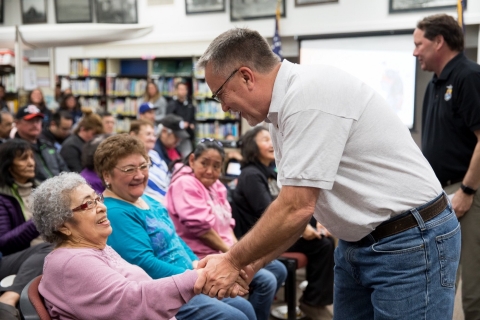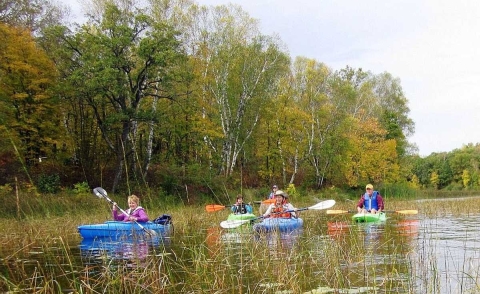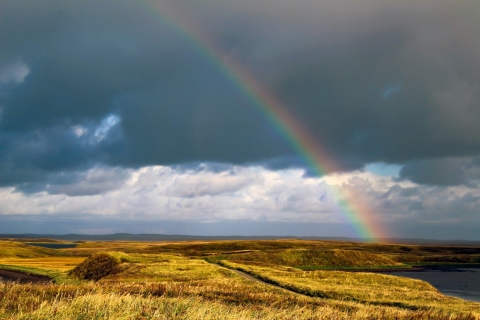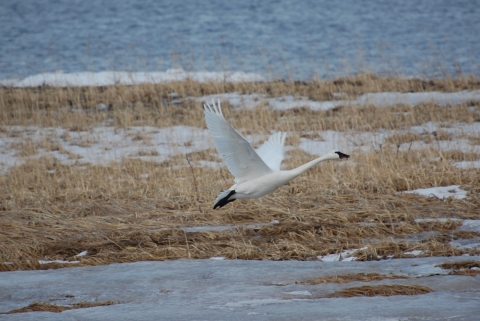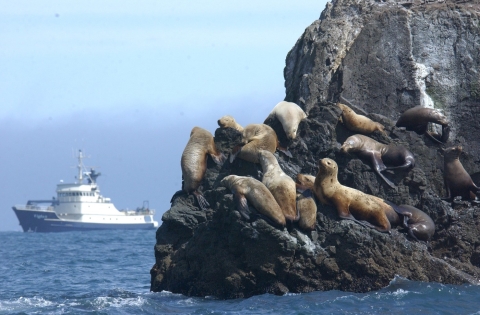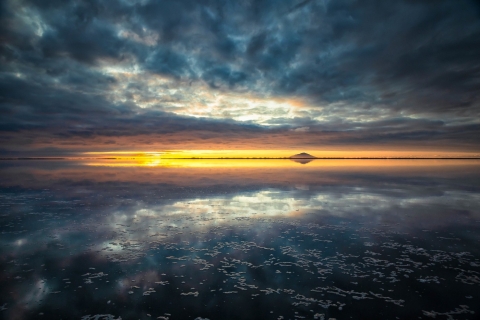In Alaska, the U.S. Fish & Wildlife Service employs a small army of dedicated and passionate staff with a large spectrum of roots. Some were born and raised in Alaska. Others have come from around the world. Regardless, some stay to do a job they feel is important enough to spend a lifetime doing. Like Greg Siekaniec, who has served the people of Alaska in numerous roles across the state for nearly two decades.
Greg Siekaniec gives a warm handshake to 90 year old internment survivor Haretina Krukoff following the USFWS’s apology 📷 USFWS/Lisa Hupp
Where are you from? How did you get introduced into nature?
I grew up in Minnesota—the western prairie region—and was fortunate enough to have exposure to what I call the “lakes country.” My parents had a cabin on a lake that we spent a great deal of time at by Tamarack National Wildlife Refuge. And as I grew up, my parents were like, “just go outside and go do things.”
“I had access to a really fun 10 foot john boat and a little 10 horsepower motor and free rein to run around.”
With access to that boat and little motor I was everywhere in that country. I figured out how I could go from one lake to the next and end up in Tamarac Refuge—the most fascinating place around. I had this inkling that someday I would really love to work with whatever that represented. At the time, though, I had no idea what a National Wildlife Refuge was about.
Kayakers in Tamarac National Wildlife Refuge, Minnesota 📸 USFWS
How did you start thinking about this as a career?
In high school, I was able to express interest to my school counselor in what I wanted to do—forestry, or something that represented that kind of outdoors work. And there was a fair amount of, “there aren’t really any jobs in that”. I got distracted by that.
So I went into construction management—a completely different degree field, and managed to start a small construction company. Worked as a building inspector for the state of Minnesota. In the back of my mind I was not doing what I really wanted. Up one day and left that other field and went back to the University of Minnesota and finished up with a degree in wildlife biology. Along the way, I found the U.S. Fish and Wildlife Service had summer intern-type programs…had summer employment programs. I started working with the Service around North Dakota, which I was hired in a kind of a crazy sort of way. They hired me for my construction skills and the ability to help them do summer projects — you know, remodel facilities and buildings and build interpretive panels and kiosks and such. That turned into knowing and getting to meet a lot of the people that eventually ended up doing the hiring in the U.S. Fish and Wildlife Service. So I that’s how I cut my path. And this is how I get into the organization.
What was your first impression of traveling to Alaska? What was it like when you arrived?
I noticed there was an opportunity up here in Alaska at a place called Izembek National Wildlife Refuge. I sat down with my wife (we had a couple of children at the time) and we talked about why was this an interest we really want to pursue, and we arrived at “Absolutely.” I put my name in the hat for the refuge manager out at Izembek Refuge, and I was fortunate enough to get the job offer. We had an unbelievably excited family on our way up with the opportunity to come up and live and work in Alaska for a while.
We put our vehicle on a ferry and rode that up through the Inside Passage. It didn’t take you very long to start realizing that, oh my gosh, the scale of Alaska is just so different than what you experienced in the lower 48. Orca whales and sea lions and things that you were starting to experience along the way was so very different than working in the Midwest and western part of the United States. We got to Haines and drove down into Anchorage. That takes two days just to make that drive. You start to realize the scale up here. It was springtime, so by the time we hit Anchorage all the leaves were on the trees and it was beautiful, warm, with temperatures probably running in the 60s and 70s.
“Everything about it was just a real welcoming sort of feel, and then a flight from Anchorage to Izembek 640 miles by air. That just starts to give you that sense of the scale of the place that you’re now headed to or you’re going to get an opportunity to live in.”
We landed, and it was one of those rare days. Cold Bay, Alaska claims to have a dozen to 15 sunny days a year. We landed on one of those remarkable days, it was calm, there was very little wind. We went for a quick ride out and around to see Izembek Lagoon, traveled up the frosty road. I’ll just see some of the landscape which we’re living in. We saw a brown bear with cubs. The cubs were maybe knee high to the to the sow and they all stood up and looked at us and you’re just kind of like, “Wow, we’ve moved to an amazingly different place.”
Rainbow over Izembek National Wildlife Refuge. 📸 USFWS/Rebecca Fabbri
“I think one of the most interesting aspects of Izembek Refuge was learning the history behind the establishment of it.”
The area was established based on conserving the entire watershed of the lagoon itself. There was a refuge manager there that was named nicknamed “Sea Otter Jones” — Bob Jones was his name. I read through the files of what he went through to establish the area. With his 10–15 year effort he prevailed, and all of the components of your ecological system are still in play: large brown bears. You learn that there are wolves around and the caribou herd is still there. There are both sea otters and land otters or river otters. There’s every Migratory Bird that’s supposed to be in the system that we know of are still utilizing the area. In the fall it fills up with Pacific black Brant and Emperor geese and Taverner’s Canada geese and all kinds of waterfowl: Pintails, Mallards, Harlequins and sea ducks. I think that was one of the most remarkable realizations that everything that was supposed to be here is still here.
“Robert Jones had a very forward-looking approach. He had worked to establish Izembek Refuge on conserving the entire watershed of Izembek Lagoon.”
What was your favorite animal to work with in Izembek?
I’ve always sort of had a real interest or passion for swans. And lo and behold, that Izembek Refuge and the lower Alaska Peninsula area had a very resident species of Tundra Swans that we actually got to work with. We would do an annual banding voyage and go out and herd the young birds together and put bands on them. To be able to live and work and to actually get hands on some of that true biology sort of stuff that makes you feel like you’re really a part of the whole system was is pretty remarkable.
Tundra Swan in Izembek National Wildlife Refuge 📸 USFWS/Kristine Sowl
How long have you been in Alaska?
We spent almost four years of the most amazing time out in Izembek with our kids being the right age. They grew up there and came to really love these wild places as well. We left for a couple of years, went back to Washington DC, but then came back to what’s called Alaska Maritime National Wildlife Refuge. It’s kind of what they describe it as the rocks, the islands, the spires of coastal Alaska. And if you were to follow the sort of distance again, I get back to this scale issue, we’d say you could travel 2,500 miles within just Alaska Maritime National Wildlife Refuge from the southeast all the way up to the Arctic coastal plain, with some of the islands and associated habitats. So we live and work out of Homer, Alaska for the Alaska Maritime for about eight or nine years. I left again, went back to DC, and headquarters office, and then went up to Canada for four years and worked as the Chief Executive Officer for Ducks Unlimited Canada, and then had the opportunity to come back to the U.S. Fish and Wildlife Service as the Regional Director here in Anchorage. So all told, I’ve probably got 17 years or so associated with working in Alaska.
Steller’s sealions in the Gulf of Alaska with the R/V Tiglax in the background within Maritime National Wildlife Refuge📸 USFWS
Why do you do what you do?
I have a passion for wild places and all of the things that go with that — the wildlife. I wish for everyone that they have an opportunity to experience Alaska at its finest. For some that would be in in the dead of winter, when you experienced minus 50 and 60 degrees, the Fairbanks area, the hot springs, the northern lights, it’s all connected to that incredibly wild landscape. I think what I’ve come to realize is I have a passion for the conservation of those types of places, but more so now even in the relationship with people that depend and utilize and also love these wild places. We’ve believed in wilderness areas for the sake of a person doesn’t necessarily have to even ever experience it by stepping foot in there. But there’s some solace in knowing that it’s actually there for future generations, that others will have that opportunity. I very much believe in that. That a lot of our work is oriented towards future generations. I’m hoping that my kids that have come to love these incredibly wild Alaskan landscapes that their children and their children’s children will have that same opportunity. I think that’s what we have here in Alaska, that we can continue to stay focused on ensuring that actually is represented for future generations.
Sunset over Izembek Lagoon 📸 Lisa Hupp/USFWS
Adapted from episode 1 of My Life, Wildlife Podcast!
In Alaska we are shared stewards of world renowned natural resources and our nation’s last true wild places. Our hope is that each generation has the opportunity to live with, live from, discover and enjoy the wildness of this awe-inspiring land and the people who love and depend on it.
Follow us: Facebook Twitter Medium
Subscribe to My Life, Wildlife! On Apple or wherever you get your podcast

